Translate this page into:
Screening levels spatial interpolation of lifetime carcinogenic risk by organochlorine pesticides across catchments of river chenab
⁎Corresponding author. adilqau5@gmail.com (Adeel Mahmood),
-
Received: ,
Accepted: ,
This article was originally published by Elsevier and was migrated to Scientific Scholar after the change of Publisher.
Abstract
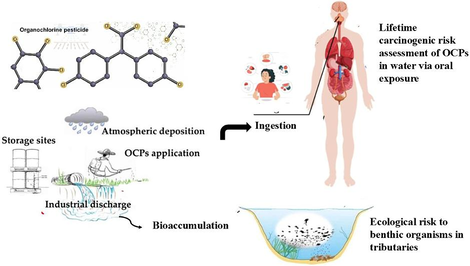
Abstract
The present study has employed an advanced GIS based statistical technique for spatial interpolation of lifetime carcinogenic risk to OCPs in water and sediments from tributaries of River Chenab. The findings revealed that among all detected isomers, DDT exhibited the highest concentrations (mean 14.41 ng/l: range 9.33 – 20.21 ng/l and mean 16.47 ng/l: range 10.55 – 21.24 ng/g) for water and sediment, respectively. Results of OCPs fingerprints revealed the presence of dicofol confirmed fresh input of OCPs isomers along with the DDTs (Dichloro-diphenyl trichloroethane) historical usages in water bodies. The evaluation of ecological risk to benthic organisms’ fish, daphnia and green algae (RQ 2 × 102) indicated that DDTs (DDD, DDE) pose potential hazardous risks (>1) to fish species across all the studied sites. Moreover, Spatial interpolation of the lifetime carcinogenic risk denoted the sites along downstream zone surpassed the permissible limit. The non-carcinogenic risk (∑HQ) ranged from 2 × 10-3 – 1.0 with the highest value for DDT, indicating DDT as a potential hazard through oral exposure (∑HQ≥1). In the case of sediments results of SQGQs (Sediment Quality Guideline Quotient) levels for DDE (Dichloro-diphenyldichloromethane) and DDD (Dichloro-diphenyl dichloroethylene) denoted a severe biological risk to ecological integrities. The findings comprehend the more inclusive monitoring of OCPs usage and distribution in the studied region to reduce risks ecological integrities and to promote good health and wellbeing’s.
Keywords
OCPs
Health Risks
Sediments
Lifetime cancer
Good health and wellbeing’s
1 Introduction
Organochlorine pesticides enter the environment via agricultural runoff, landfill dumping, and wastewater discharge. As a crucial environmental compartment, freshwater plays a potent role in the transformation and relocation of OCPs across several spatiotemporal settings (Olisah et al., 2020; Tzanetou and Karasali, 2022). OCPs inflowing the aquatic ecosystem may bioaccumulate in the tissues of organisms in succession to trophic levels including algae, oysters, fish, and eventually be moved to the higher trophic levels such as birds and humans in terrestrial ecosystem (Ceschin et al., 2021). The consternation over OCPs contamination have risen in recent years owing to the discovery of various chemicals and metabolites that may alter the functions of enzymes, neurotransmitters, some hormones and growth factors (Baqar et al., 2017). These pollutants tend to remain in fatty tissues for a longer period, which results in chronic concerns like birth abnormalities, a decreased ability to fight off infections, delayed development, and permanent damage of brain function, carcinoma, intellectual disabilities, breathing problems including allergies, and psychological, mental, immune-mediated, and reproductive disabilities (Popli et al., 2022; Adeyi et al., 2021; Fernandes et al., 2023; Vegh et al., 2023).
OCPs move into the food chain via water and sediments, biomagnifying in plants and human tissues, causing potential health risks (Ali et al., 2016; Siddique et al., 2024; Dokic et al., 2024). Therefore, monitoring of organochlorine pesticides in environmental matrices including water and sediments is crucial to prevent human and ecological health risks (Nadunda et al., 2018; Gong et al., 2020). Worldwide, developing countries including Pakistan have scarce data on the concentration profile, distribution and health risk evaluation of OCPs in sediments and water (Siddique et al., 2024; Mahmood et al., 2014). Despite the ban under Stockholm convention OCPs are still used in the region (Siddique et al., 2024). To the best of pertinent literature survey, no study has comprehensively illustrated the source apportionment and spatial distribution patterns with GIS based integrated approaches to determine the risk to ecological entities along with human health risk assessment of OCPs in water and sediments from the study area. Therefore, this study will play a pivotal role in addressing the gap by using an advanced geostatistical approach.
2 Materials and methods
2.1 Study area
The research area is located across the River Chenab, which originates from the snow-capped Himalaya ranges in Himachal Pradesh, India and flows to Pakistan (Fig. 1). The Palkhu and Aik are important tributaries of the Chenab River, which originate from Jammu and Kashmir, India, and drain an area of about 1,875 km2 towards Pakistan.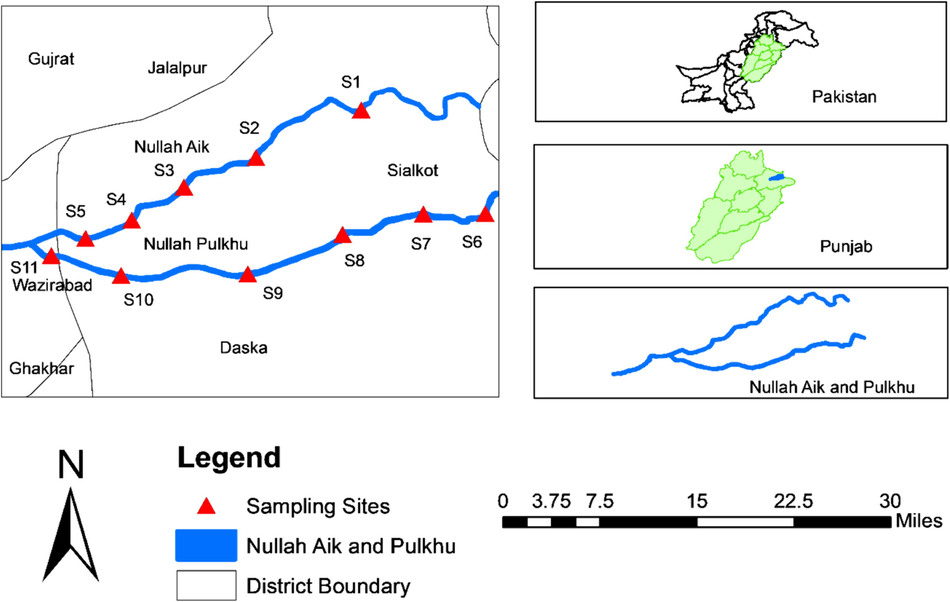
Map of sampling location across tributaries of river Chenab, Pakistan.
2.2 Sampling strategy
A total of eleven sampling points were selected for water and sediment sampling along Pulkhu and Aik, tributaries, each sampling site was further subdivided into three sub-sites, which results in a total of 33 sampling sites. The area under study was distributed into three sub zones depending on the origin of tributaries, level of anthropogenic activities and habitat variation. The upstream zone was located in a rural area consisting of agricultural land. The second midstream zone received urban runoff and discharge from several industries in Sialkot. The third zone was situated downstream of tributaries, including peri-urban and some urban sites of Sialkot. The water of these tributaries is used for irrigation to adjacent crop fields.
2.2.1 Water and sediment sampling
Water samples (n = 99) were gathered from below the top surface at depth of approximately 2.5 m in 5 L sterilized sampling jars. Each sample was a composite of 3 subsamples. Sediment samples (n = 99) were collected from each respective site and sub-site of the study area. Composite sampling was employed for sample collection, stored in polythene airtight bags and transferred to the laboratory.
2.3 Chemical analysis
2.3.1 Sample preparation
Sediment samples were extracted following the protocol of solid–liquid extraction. Extraction of water samples was performed using liquid–liquid extraction in a 1L separatory funnel. Before the extraction TCMX (2,4,5,6-tetrachloro-m-xylene) was added in every sample as surrogate standard (Baqar et al., 2018). Extracts were dried through a rotary evaporator after an exchange of the solvent phase to hexane. Column Elution was done with 50 mL solution of Dichloromethane and hexane (1:1) (Mahmood et al., 2014). After adding solvent keeper dodecane (25 μl), the extract was kept under a nitrogen stream to concentrate. All samples were spiked with a known concentration of PCB-209 (Internal standard).
2.3.2 Chromatographic analysis
Isomers of OCPs, including alpha-hexachlorocyclohexane (α-HCH), beta-hexachlorocyclohexane (β-HCH), Σendosulfan, dichloro-diphenyldichloroethylene (DDD), dichloro-diphenyltrichloroethane (DDT), dichloro-diphenyldichloroethane (DDE), and chlorothalonil were determined using GC-ECD containing DB-5 capillary column (30 m × 0.25 mm × 0.25 μm). Nitrogen was used as mobile phase. The rate of flow of column was kept at 1.8 ml per min. Split less mode of injector was regulated at 250 °C. At first, the column temperature was adjusted for 3 min at 50 °C, then enhanced for 20 min at 20 °C/min to 280 °C.
2.3.3 Quality control protocol (QA/QC)
All chemicals and reagents were of analytical grade (MERCK, Germany) and were analyzed for false peaks. Surrogate and internal standards were acquired from Germany (Dr. Ehrenstorfer GmbH). The ratios of recovery and blanks were employed to validate the analytical results. The calibration curves was prepared using standard solutions of various concentration including 2, 10, 20, 50, 100 and 200 μg/L (Baqar et al., 2018). The recoveries of surrogate (2,4,5,6- tetrachloro-m-xylene) varied from 57 % to 69 %, however the mean recovery for internal standard (decachlorobiphenyl) was 78 %.
2.4 Human health risk assessment
2.4.1 Lifetime carcinogenic risk assessment (LCR)
In current study lifetime carcinogenic risk to human health via oral exposure route was calculated using USEPA guidelines as mentioned by Bai et al., 2018 and Siddique et al., 2023a.
Where C indicates level of investigated isomer of OCP (ng/l), DI denotes dietary intake (2L/day), EF indicates exposure frequency (365 days/year), ED refers to the exposure duration (67 years), AT indicates average lifetime (25, 550 days), BW represents body weight (72 kg) and SF indicates slope factor.
2.4.2 Non cancer risk (HQ)
The evaluation for non-carcinogenic risk (HQ) to consumers was done using the following equations.
Where CDI refers to chronic daily intake, Rf indicates reference dose. The USEPA- IRIS Rf values were used to assess non-cancer risk.
2.5 Ecological risk assessment for OCPs from water
Risk to ecological entities linked to OCPs was evaluated using the risk quotient method used in many studies following USEPA guidelines (Sultan et al., 2023; Baqar et al., 2020; Chen et al., 2020). Ecological risk at three trophic levels to different freshwater organisms, i.e. fish, daphnia and green algae was calculated using equations.
Where MEC is measured environmental concentration and PNEC is ratio between calculated EC50/LC50 values of OCPs and Assessment factor (AF=1000) for fish, Daphnia and green algae. The values for EC50 of organisms were acquired from the US EPA ECOTOX database (S1 Table 2) (Sultan et al., 2023).
2.5.1 Ecological risk assessment for OCPs from sediment
The risk to ecological integrities of investigated OCPs was evaluated using sediment quality guidelines and sediment quality guideline quotient method (Emoyan et al., 2021).
Where PELQi refers to PEL quotient for pollutant i, n is the number of analyzed isomers having SQGs, Ci denotes level of OCP, and PEL indicates probable effect level for pollutant.
3 Results and discussions
3.1 General profile of OCPs in water and sediments
The residues of ΣOCPs in water ranged from 46.92 – 116.89 ng/l with average concentration of 85.55 ng/l and in sediment samples the concentration varied from 47.54 –175.89 ng/g with average concentration of 115.07 ng/g. All studied isomers were detected in water and sediment samples (Table 1). Current OCPs levels from water were found to be greater than reported data from tributaries of River Ravi (Baqar et al., 2018), Chenab (Mahmood et al., 2014); The Daye Lake, China (Bhutto et al., 2021); River Brandhu (Taufeeq et al., 2021). OCPs from sediments were detected in lower levels than reported from tributaries of River Ravi (Baqar et al., 2018). The compounds of OCPs settle down at the bottom and are ultimately leached from the surface water. Afterward, pesticides are reintroduced into water, contributing to detectable levels in water and aquatic life. This fact may be linked to the higher levels of OCPs in sediments compared to water. Current findings are in accordance with reports (SI Table 1) from many other previously published studies (Baqar et al., 2018; Mahmood et al., 2014; Shah and Parveen, 2021).
Sediment
Water
OCPs
Mean
St. d
Min
Max
Median
Mean
St. d.
Min
Max
Median
DDT
16.5
3.55
10.5
21.2
16.2
14.4
3.35
9.33
20.2
14.9
DDD
16.4
3.89
10.4
22.9
15.9
13.5
3.10
8.27
18.3
14.3
DDE
16.4
4.76
9.76
24.5
15.7
13.9
3.12
9.29
18.6
13.9
α-ES
6.5
3.41
0.04
10.2
7.23
2.91
1.41
0.98
5.29
2.95
β-ES
6.2
3.77
1.01
12.3
6.73
3.25
1.33
1.43
5.46
3.13
ƩES
12.6
6.93
1.05
22.5
13.7
6.16
2.72
2.41
10.6
6.08
α-HCH
8.4
3.29
3.33
13.7
7.99
6.38
1.61
2.43
8.69
6.31
β-HCH
10.6
3.95
4.01
16.5
11.2
6.97
1.40
4.32
9.97
6.98
ƩHCH
18.9
7.10
7.34
28.8
19.4
13.3
2.96
6.75
18.6
13.2
CT
2.64
1.66
0.01
4.58
3.28
4.66
2.15
1.22
7.25
5.54
PELQi
DDT
DDD
DDE
ƩDDTs
SQGQ
S1
2.99
1.53
1.96
0.78
1.82
S2
3.40
1.48
2.11
0.83
1.95
S3
3.77
1.88
2.33
0.96
2.23
S4
3.97
2.02
2.85
1.07
2.48
S5
4.45
2.34
3.16
1.21
2.79
S6
2.21
1.23
1.45
0.59
1.37
S7
2.64
1.62
1.48
0.70
1.61
S8
2.77
1.88
2.14
0.84
1.91
S9
3.35
2.10
2.40
0.97
2.21
S10
3.99
2.51
3.15
1.19
2.71
S11
4.45
2.70
3.64
1.33
3.03
3.2 Source apportionment of OCP isomers
3.2.1 DDT
Our finding is in accordance with the trends reported in previous studies (Gong et al., 2020; Baqar et al., 2018; Mahmood et al., 2014). Oxidation-dehydrochlorination process results in degradation of DDTs into DDE in the presence of O2, while the reductive-dichlorination process results in decomposition to DDD in the absence O2 (Baqar et al., 2018). Results of the current findings revealed that the proportion of DDT degraded products viz; DDE and DDD was 21 % and 20 % in water and sediment respectively, exhibiting consistent degradation of DDT isomers. The ratio of (DDE+DDD) / ∑DDTs was used to detect contamination source. The calculated ratio ranged from 1.82 to 2.10 and 1.87 to 2.09 with mean values of 1.95 and 1.96 for water and sediment samples, respectively, confirming the historical usage of DDTs in the study area (SI Figs. 1 and 2). Previously published results on riverine systems of different countries were found similar to the current result pattern for source apportionment (Mensah et al., 2012; Mitra et al., 2019; Montouri et al., 2020; Bhutto et al., 2021). DDTs decomposition was evaluated using the ratio of DDE/DDD, and ratios ranged from 0.97 to 1.04 and 0.93 to 1.06 with the mean of 1.01 and 0.99 in water and sediment samples, respectively, which confirmed the usage of dicofol in the study area. Ban on the technical mixture in Pakistan promoted the use of dicofol which comprised approximately 5 % DDT.
3.2.2 HCH
Among HCH, β-HCH was the prevalent isomer constituting 11 % and 13 % of detected isomers of organochlorine pesticides in water and sediments, respectively. β-HCH has high persistence owing to its lower vapor pressure. The present study findings are in accordance with the reports from proximate study areas from Pakistan (Mahmood et al., 2014; Baqar et al., 2018; Syed et al., 2014a; Gong et al., 2020). Ratio of β-HCH/ΣHCHs above 0.5 (mean: 0.64) in most sampling sites denoted the historical deposition, while the ratio of β-HCH/(α-HCH+β-HCH) was evaluated and ratio found from 0.51 to 0.56 (mean: 0.53) in water and from 0.55 to 0.57 (mean: 0.56) in sediments, indicated restricted influence of atmospheric transport as a source apportionment of HCHs.
3.2.3 Endosulfan
Among Endosulfan, β-endosulfan was the dominant isomer in water constituting 5 % in detected isomers of OCPs. This finding may be linked to the fact that degradation of α-endosulfan is relatively easier and higher as compared to β-endosulfan (Wang et al., 2016). The ratio of α-endosulfan/β-endosulfan is a widely used method to assess the history and source of contamination (Vudamala et al., 2023). In the current study, α-endosulfan/β-endosulfan proportions ranged from 0.67 to 0.95 (mean: 0.83) in water and from 0.06 to 1.33 (mean: 0.77) in sediments, signifying historic as well as the recent input in the study area. This finding is in line with the reports of Taufeeq et al., 2021 and Baqar et al., 2018; Wang et al., 2016. Moreover, the results are validated by the reports of current usage of endosulfan for industrial and agricultural applications in the study area (Mahmood et al., 2014).
3.3 Spatial distribution pattern of OCPs
The GIS-based spatial profile analysis (Figs. 2-3) indicated the highest contamination load of OCPs in sediments at downstream along site 11 and 5 along Aik and Palkhu tributary (SI Figs. 3-4). This finding may be attributed to the fact that OCPs mainly originate from silt through erosion into the river and are carried downstream with the flow of water, ultimately accumulating in the sediment. Thus, the downstream rivers act as stores of these pollutants (Gong et al., 2020; Taufeeq et. al 2021; Ndunda et al., 2018). In the rainy season, water currents transport sediments downstream, contributing to a high contamination load in the studied zone (Baqar et al., 2018). It has been assessed that at sites across the midstream zone (S9, S10 of Nullah Palkhu, and S3 of Nullah Aik) exhibited considerable pollution loads 122.6 ng/g, 143.5 ng/g, and 121.4 ng/g, respectively. The points of studied tributaries receive wastewater discharge from several industrial units present in the catchment area.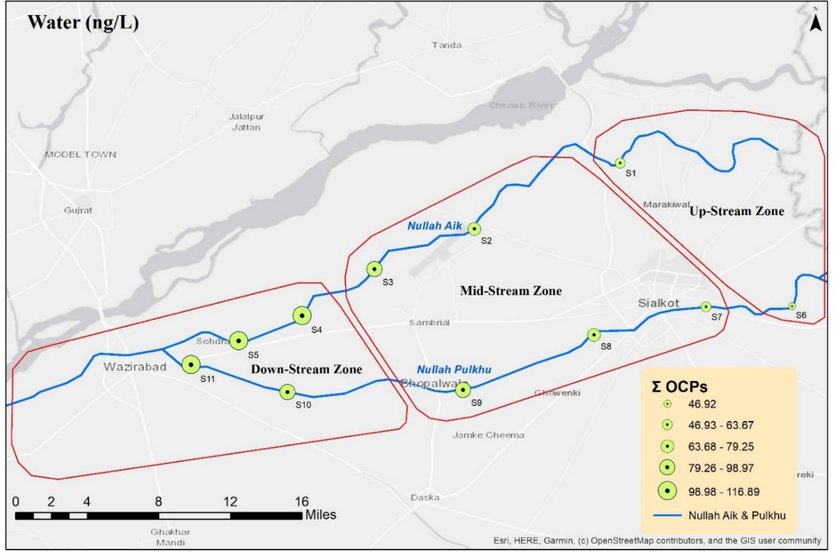
Spatial distribution pattern of organochlorine pesticides in water samples from both tributaries.
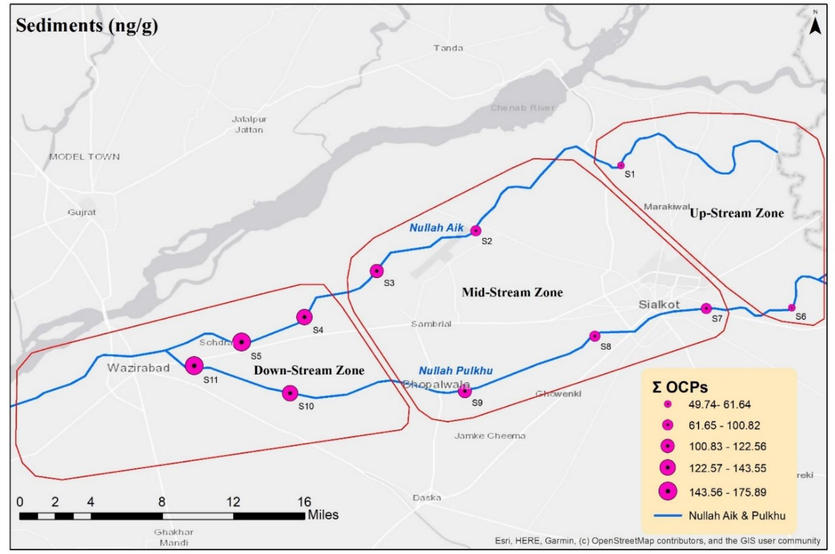
Spatial distribution pattern of organochlorine pesticides in sediments from both tributaries.

Ecological risk quotient (site-wise) for fish, daphnia, and green algae from the tributaries. (For interpretation of the references to colour in this figure legend, the reader is referred to the web version of this article.)
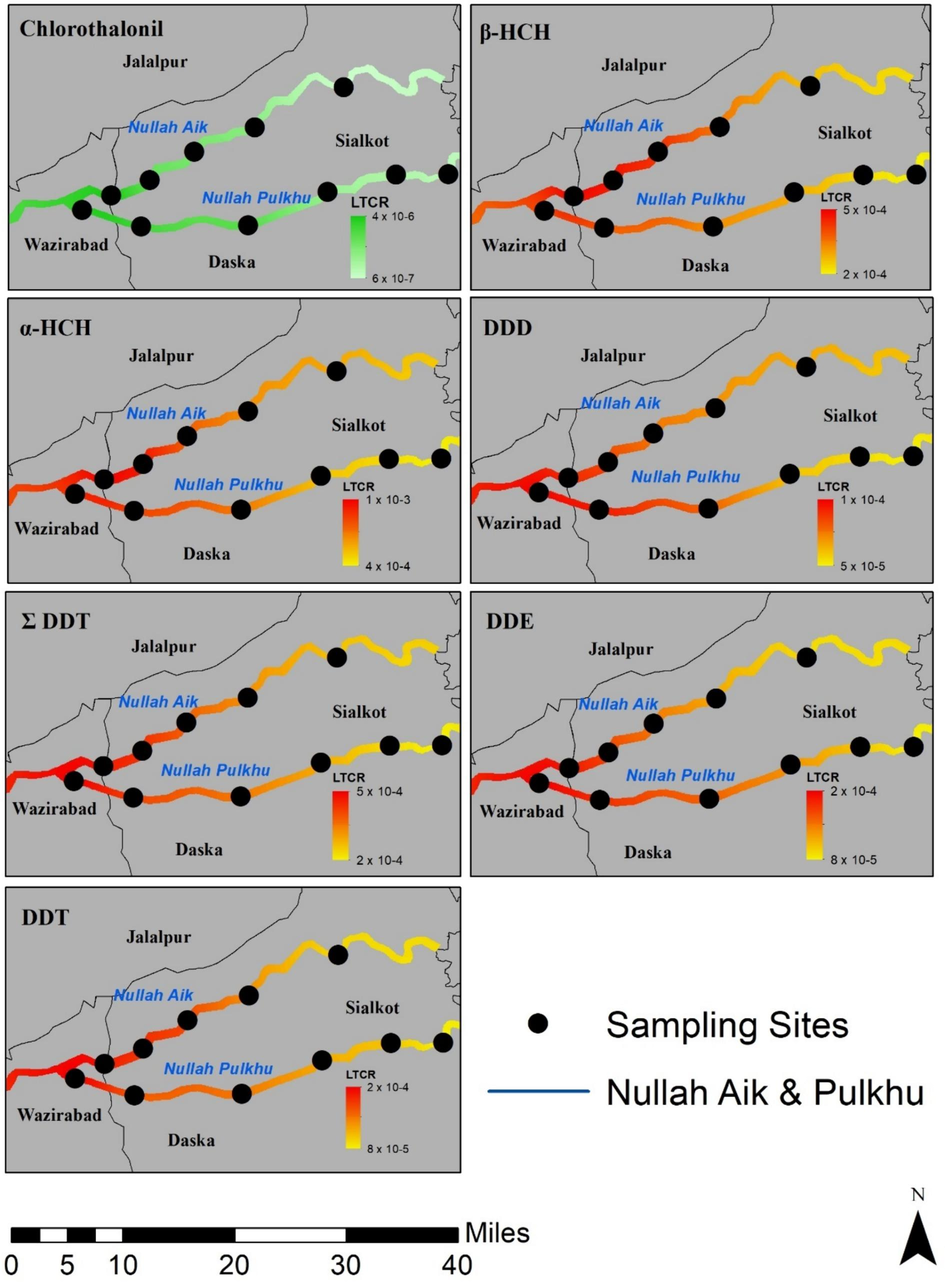
Integrated GIS approach based carcinogenic risk assessment of OCPs via oral exposure.
Evaluation of the results revealed the lowest concentration of OCPs across upstream zone at site 6 (49.7 ng/g) along Nullah Palkhu and at site 1 (61.64 ng/g) along Nullah Aik. Upstream zone is an agricultural and rural area where the current usage of pesticides may have contributed to detected pollution levels. OCP distribution trend in the water of tributaries at all studied zones was similar as of sediment with the highest pollution load (116. 89 ng/g) downstream in addition to the waters of Nullah Aik (S5) was found to be more contaminated than that of Nullah Palkhu (110.04 ng/g) owing to the urban and industrial activities in the catchment area.
3.4 Risks to ecological integrities
The values of ecological risk of OCPs are based on the detected concentration and toxic properties of OCP isomer (Taufeeq et al., 2021). Risk quotient values calculated for benthic organisms (daphnia, green algae, fish) are shown in SI Table S2. The trend obtained after risk evaluation is presented in a heat map (Fig. 4). DDT, DDD, DDE exhibited (>1) highest risk for fish and daphnia for all sites with the highest risk quotient (2 × 102) for DDT. Whereas β-endosulfan and β-HCH showed (<1) minimal risk for all investigated species, indicating the medium level risk to studied organisms. The risk quotient for α-endosulfan was found > 1 for fish species at all sites while for α-HCH (>1) among maximum studied sites. In general, our results reflected a higher risk to fish and daphnia from investigated OCPs.
In addition, ecotoxicological risks to benthic organisms by OCPs in sediments were evaluated by comparing levels with sediment quality guidelines as Pakistan has no standards for comparison (CCME 1999; Nadunda et al., 2018; He et al., 2023; Yang et al., 2020). The current results revealed that levels of DDT, DDE and DDD were greater than the values recommended by guidelines i.e. ISQG (Australian interim sediment quality guideline), TEL (threshold effect level) and PEL (probable effect level) indicating the high chances of severe biological effects on biota due to exposure to OCPs in sediments at investigated sites. This finding is in line with the reports conducted by other authors in Pakistan (Baqar et al., 2018; Mahmood et al., 2014). However, after a comparison of mean levels of PEC (probable effect level), it was found that all sampling sites have lower concentrations than recommended PEC value. In addition, the sediment risk quotient was evaluated to measure and categorize biological effects caused by OCP exposure to biota (Montouri et al., 2020; Wang et al., 2016). The Value of SQGQ (Sediment quality guideline quotient) < 0.1 indicates no effects; > 0.1 and < 1 represents moderate effects and SQGQ greater > 1 exhibit higher biological effects (Table 2). Assessment of our findings revealed that SQGQ calculated for DDT, DDE, DDD and ∑DDT were found > 1, indicating sever biological risk to ecological integrities through exposure to investigated OCPs (SI Fig. 5).
3.5 Health risk evaluation of OCPs in water
The OCPs due to lipophilic nature can accumulate in liver, fate and breast milk causing detrimental health risk including developmental abnormalities in fetus, carcinogenicity, neurological and immunological disorders (Wang et al., 2016). Previously published reports from the region reflected that the water of tributary Aik and Nullah is used extensively for irrigation to nearby agricultural fields including vegetables and cereal crops (Qadir et al., 2008; Mahmood et al., 2014; Ullah et al., 2016; Siddique et al., 2023b). Considering the detrimental toxicological effects of OCPs, lifetime carcinogenic risk (Fig. 5) and noncarcinogenic risk of OCPs in water through oral exposure were evaluated using an advanced geostatistical approach (ArcMap 10.8, Kriging) for spatial interpolation of cancer risk to OCPs in water.
In accordance with literature reports ingestion has been reported as major route of exposure of OCPs to human body across the riverine channels (Bai et al., 2018; Mitra et al., 2019). Results of cancer and non-cancer risk evaluation are presented in Table 3. It was found that values for non-carcinogenic risk (∑HQ) ranged from 2 × 10-3 − 1.00 with the highest value for DDT, indicating DDT as a potential hazard through oral exposure (∑HQ≥1). Assessment of the findings revealed that mean ∑HQ ranged from 5 × 10-1 − 1.00, 2 × 10-2 − 5 × 10-2, 6 × 10-3 − 3 × 10-2, 6 × 10-3, 2 × 10-3 − 1 × 10-2 for DDT, DDE, ƩES, α-HCH and CT respectively, suggesting negligible non-carcinogenic risk to consumers. These findings are in line with previously published reports from Punjab (Siddique et al., 2023b; Mahmood et al., 2014). *Reference dose *Oral slope factor
Cancer risk
Non cancer risk
OCPs
OSF (mg/kg/day)
Rf (mg/kg/day)
Mean
Range
Mean
Range
DDT
0.34
0.0005
1.3 × 10-4
8.4 × 10-5 − 1.8 × 10-4
7.7 × 10-1
5.0 × 10-1 − 1.1
DDD
0.24
8.6 × 10-5
5.3 × 10-5 − 1.2 × 10-4
DDE
0.34
0.01
1.3 × 10-4
8.4 × 10-4 − 1.7 × 10-4
3.7 × 10-2
2.5 × 10-2 − 4.9 × 10-2
ƩDDTs
0.34
3.8 × 10-4
2.4 × 10-4 − 5.2 × 10-4
αES
βES
ƩES
0.01
1.60 × 10-2
6.4 × 10-3 − 2.9 × 10-2
αHCH
6.3
0.01
1.1 × 10-3
4.1 × 10-4 − 1.5 × 10-3
1.70 × 10-2
6.5 × 10-3 − 2.3 × 10-2
βHCH
1.8
3.3 × 10-4
2.1 × 10-4 − 4.8 × 10-4
ƩHCH
CT
0.02
0.02
2.50 × 10-6
6.5 × 10-7 − 3.9 × 10-6
6.2 × 10-3
1.6 × 10-3 − 9.6 × 10-3
The findings of GIS based risk approach to determine cancer risk to local people through oral intake are presented in Fig. 5. The mean values for quantified cancer risk ranged from 6.5 × 10-7 – 1.5 × 10-3 with the highest carcinogenic risk of α-HCH at all sampling sites of the study area. Investigation of the findings revealed that DDT, DDD, DDE, ƩDDTs, α-HCH and β-HCH are posing significant cancer risk and the results of our evaluation were found higher than the permissible limit (1 0−6) recommended by USEPA. Current results are comparable with findings of studies carried out in Pakistan (Baqar et al., 2018; Taufeeq et al., 2021; Siddique et al., 2023). Similar findings have also been reported in studies conducted in China (Chen et al., 2020; Chen et al., 2021; Bai et al., 2018).
4 Conclusion
The present study is a crucial breakthrough in developing baseline data about concentration profile, source apportionment along with carcinogenic and ecological risks of OCPs to human and ecological integrities respectively as no study has been conducted in the studied region to evaluate the risks of banned OCPs using holistic approach. The assessment of the findings showed higher OCPs levels in sediments as compared to water from tributaries of the Chenab River due to their greater accumulation potential for organic contaminants. The findings of source apportionment denoted the fresh and historical input of all detected isomers. The lifetime carcinogenic risk assessment via GIS-based geostatistical approach revealed that the health risk for metabolites of DDT and HCH in water surpassed the permissible limit of carcinogenic risk recommended by USEPA (1 0−6). Moreover, the ecological risk quotient values obtained for DDT congeners signified the high risk to benthic organisms in water. Furthermore, the high ecological risk to isomers of DDT in sediments was unveiled by obtaining the sediment quality guideline quotient. Hence, the findings of risk assessment in the present work delineate the need for regular pesticide monitoring along the catchment area of River Chenab to prevent the risk to ecological entities and toxic health impacts to humans as the water of tributaries is used for irrigation to adjacent fields.
Fundings
“No funding was obtained for this study”.
CRediT authorship contribution statement
Taiba Tariq: Writing – original draft, Methodology, Investigation, Data curation. Adeel Mahmood: Writing – original draft, Supervision, Project administration, Methodology, Data curation, Conceptualization. Muzafar Majid: Writing – review & editing, Supervision. Rabia Nazir: Validation, Formal analysis. Abdallah M. Elgorban: Writing – review & editing, Resources. Islem Abid: Writing – review & editing, Resources. Rizwan Ullah: Writing – review & editing, Data curation. Lalita Ambigai Sivasamugham: Validation, Resources.
Acknowledgments
The authors extend their appreciation to the Researchers supporting project number (RSPD2024R745), King Saud University, Riyadh, Saudi Arabia.
Declaration of competing interest
The authors declare that they have no known competing financial interests or personal relationships that could have appeared to influence the work reported in this paper.
References
- Occurrence, distribution, and risk of organochlorine pesticides in food and greenness assessment of method. Environ. Sci. Pollut. Res.. 2021;28(25):33433-33444.
- [CrossRef] [Google Scholar]
- Significance of black carbon in the sediment–water partitioning of organochlorine pesticides (OCPs) in the indus river, pakistan. Ecotoxicol. Environ. Saf.. 2016;126:177-185.
- [CrossRef] [Google Scholar]
- Residues of organochlorine pesticides (OCPs) in aquatic environment and risk assessment along Shaying River, China. Environmental Geochemistry and Health. Official journal of the Society for. Environ. Geochem. Health. 2018;40(6)
- [CrossRef] [Google Scholar]
- Persistent organic pollutants in Pakistan: Potential threat to ecological integrities in terms of genotoxicity and oxidative stress. Hum. Ecol. Risk Assess.. 2017;23(6):1249-1271.
- [CrossRef] [Google Scholar]
- Organochlorine pesticides across the tributaries of River Ravi, Pakistan: Human health risk assessment through dermal exposure, ecological risks, source fingerprints and spatio-temporal distribution. Sci. Total Environ.. 2018;618:291-305.
- [CrossRef] [Google Scholar]
- Occurrence and distribution of OCPs and PAHs in water, soil and sediment of Daye Lake. J. Geochem. Explor.. 2021;226
- [CrossRef] [Google Scholar]
- Canadian Council of Ministers of the Environment (CCME) (1999) Canadian soil quality guidelines for the protection of environmental and human health. CCME, Winnipeg.
- Aquatic plants and ecotoxicological assessment in freshwater ecosystems: a review. Environ. Sci. Pollut. Res.. 2021;28(5):4975-4988.
- [CrossRef] [Google Scholar]
- Potential health risk assessment of HFRs, PCBs, and OCPs in the yellow river basin. Environ. Pollut.. 2021;275:116648
- [CrossRef] [Google Scholar]
- Ecological and health risk assessment of organochlorine pesticides in an urbanized river network of shanghai, china. Environ. Sci. Eur.. 2020;32(1)
- [CrossRef] [Google Scholar]
- Distribution of pesticides and polychlorinated biphenyls in food of animal origin in croatia. Foods.. 2024;13(4)
- [CrossRef] [Google Scholar]
- Occurrence, origin, ecological and human health risks of organochlorine pesticides in soils from selected urban, suburban and rural storm water reservoirs. Soil Sediment Contam.. 2022;31(2):152-175.
- [CrossRef] [Google Scholar]
- The bitter side of teas: Pesticide residues and their impact on human health. Food Chem. Toxicol.. 2023;179:113955
- [CrossRef] [Google Scholar]
- The occurrence of organochlorine pesticides (OCPs) in riverine sediments of hilly region of southern China: Implications for sources and transport processes. J. Geochem. Explor.. 2020;216
- [CrossRef] [Google Scholar]
- Pollution status, distribution, source analysis, and risk assessment of OCPs in soil from the hexi corridor in northwest china. Journal of Environmental Exposure Assessment.. 2023;2:17.
- [CrossRef] [Google Scholar]
- Human health risk assessment and dietary intake of organochlorine pesticides through air, soil and food crops (wheat and rice) along two tributaries of river Chenab. Pakistan. Food and Chemical Toxicology.. 2014;71:17-25.
- [CrossRef] [Google Scholar]
- Determination of organochlorine pesticide residue in sediment and water from the Densu river basin. Ghana. Chemosphere.. 2012;86(3):286-292.
- [CrossRef] [Google Scholar]
- Characterization, source identification and risk associated with polyaromatic and chlorinated organic contaminants (PAHs, PCBs, PCBzs and OCPs) in the surface sediments of Hooghly estuary. India. Chemosphere.. 2019;221:154-165.
- [CrossRef] [Google Scholar]
- Organochlorine pesticides in sediment and water from nairobi river, kenya: levels, distribution and ecological risk assessment. Kenya: Environmental Science and Pollution Research; 2018. 10.1007/s11356-018-3398-8
- Occurrence of organochlorine pesticide residues in biological and environmental matrices in Africa: A two-decade review. Heliyon.. 2020;6(3):e03518.
- [Google Scholar]
- Persistent organic pollutants in foods, their interplay with gut microbiota and resultant toxicity. Sci. Total Environ.. 2022;832:155084
- [CrossRef] [Google Scholar]
- Spatio-temporal variations in water quality of nullah Aik-tributary of the river Chenab. Pakistan. Environmental Monitoring Assessment.. 2008;140(1–3):43-59.
- [Google Scholar]
- Pesticides pollution and risk assessment of river ganga: A review. Heliyon.. 2021;7(8)
- [CrossRef] [Google Scholar]
- Comprehensive GIS based risk surveillance of organochlorine pesticides (OCPs) in edible fish species of river chenab, pakistan. Sci. Total Environ.. 2023;871
- [CrossRef] [Google Scholar]
- Ecological and human health hazards; integrated risk assessment of organochlorine pesticides (OCPs) from the chenab river, pakistan. Sci. Total Environ.. 2023;882
- [CrossRef] [Google Scholar]
- Risk surveillance with spatial distribution of Organochlorine Pesticides (OCPs) from sedimentary samples of Chenab River. Sci. Total Environ.. 2024;912:169256
- [CrossRef] [Google Scholar]
- Organochlorine pesticides (OCPs) in freshwater resources of Pakistan: A review on occurrence, spatial distribution and associated human health and ecological risk assessment. In Ecotoxicology and Environmental Safety.. 2023;249
- [CrossRef] [Google Scholar]
- Pesticide residues in fruits and vegetables from Pakistan: a review of the occurrence and associated human health risks. Environ. Sci. Pollut. Res.. 2014;21(23):13367-13393.
- [CrossRef] [Google Scholar]
- Assessment of organochlorine pesticides and health risk in tobacco farming associated with river barandu of pakistan. Environ. Sci. Pollut. Res.. 2021;28(29):38774-38791.
- [CrossRef] [Google Scholar]
- A comprehensive review of organochlorine pesticide monitoring in agricultural soils: The silent threat of a conventional agricultural past. Agriculture. 2022;12(5):728.
- [CrossRef] [Google Scholar]
- Higher concentrations and ecological risks of selected persistent organic pollutants in macrobrachium lamarrei from the streams of sialkot, pakistan. J. Agric. Sci. Technol.. 2016;27–34
- [CrossRef] [Google Scholar]
- Pesticide residues in bee bread, propolis, beeswax and royal jelly – A review of the literature and dietary risk assessment. Food Chem. Toxicol.. 2023;176:113806
- [CrossRef] [Google Scholar]
- Distribution of organochlorine pesticides in surface and deep waters of the southern indian ocean and coastal antarctic waters. Environ. Pollut.. 2023;321
- [CrossRef] [Google Scholar]
- Occurrence, sources, and risk assessment of OCPs in surface sediments from urban, rural, and reclamation-affected rivers of the pearl river delta, china. Environ. Sci. Pollut. Res.. 2016;24(3):2535-2548.
- [CrossRef] [Google Scholar]
- Concentrations, distributions, sources, and risk assessment of organochlorine pesticides in surface water of the east lake, china. Environ. Sci. Pollut. Res.. 2020;21(4):3041-3050.
- [CrossRef] [Google Scholar]
Appendix A
Supplementary data
Supplementary data to this article can be found online at https://doi.org/10.1016/j.jksus.2024.103422.
Appendix A
Supplementary data
The following are the Supplementary data to this article:







